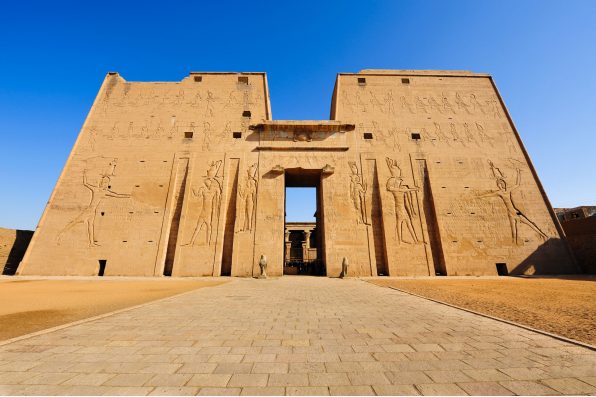Rare Traces Of Gold Leaf And Graffiti Were Discovered At An Ancient Egyptian Temple, Suggesting The Building Was Originally Bright And Vibrant

At an ancient Egyptian temple, rare traces of gold leaf and graffiti were uncovered. A team of researchers from the Julius Maximilian University of Würzburg, Germany, made the discovery during ongoing restoration works.
The Temple of Edfu is located on the west bank of the Nile. It is considered to be the most well-preserved sanctuary in ancient Egypt. The temple was dedicated to Horus, the sky god.
It was built and decorated over the span of 180 years, between 237 and 57 B.C. During this period, Egypt was ruled by the Ptolemaic dynasty, which originated from the ancient kingdom of Macedon.
In the past, the temple was situated in the midst of a regional capital and served as a center of learning and higher education.
The building measures about 450 feet long, roughly 250 feet wide, and 115 feet tall. Its entire surface is covered with hieroglyphic inscriptions and images that feature various religious texts and scenes.
“Today, the temple’s importance is that it is almost completely preserved,” said Martin Stadler, chair of Egyptology at the University of Würzburg. “The Temple of Horus at Edfu is considered the icon of a typical Egyptian temple and part of any sightseeing tour in Egypt.”
Stadler and colleagues have been working with Egyptian restorers from the Ministry of Tourism and Antiquities. The restoration efforts have involved cleaning surface areas covered with dust, dirt, and bird droppings.
Since the temple’s excavation in 1860, it has accumulated plenty of grime throughout the years. The work enabled the research team to identify and document traces of gold leaf and the colorful remains of graffiti in certain parts of the temple.
The inscriptions and images on the structure’s walls are part of a wealth of information collected over the last couple of decades that challenge the traditional image of what ancient Egyptian buildings were like. The traditional image is characterized by white temples and statues, but many ancient buildings and sculptures were actually multicolored.

Eishier – stock.adobe.com – illustrative purposes only
“The rediscovery of the multicolored temples of Egypt will revolutionize the impression of the sanctuaries, which currently appear mostly as brownish-beige monoliths that hardly stand out against the background of the desert landscape,” said Stadler.
The newly uncovered details and patterns give off the impression that the building was originally bright and vibrant, representing the cosmos based on Egyptian ideals.
Previously, research has suggested ancient Egyptian temples were not only colorful but they also were decorated with gold.
Since the start of the Pharaonic Era, which lasted from around 3100 B.C. to 323 B.C., gates, columns, and other architectural elements appear to have been covered in gold.
However, gold leaf decorations are rarely preserved. The material is incredibly fragile and usually decays without leaving behind a trace. Sometimes, the gold leaf would be removed on purpose for its value.
Now, the researchers have found traces of gold leaf decoration higher up on the walls of one of the temple’s central rooms, known as the barque sanctuary.
They also discovered “dipinti,” or graffiti painted in ink. It was written in the ancient Egyptian Demotic script, which was developed as a sort of shorthand since writing hieroglyphics would’ve been too complicated and time-consuming.
Demotic was used starting from the 7th century B.C. It was common at the time the temple was constructed.
Only about 10 percent of the population knew how to write the Demotic script, so the graffiti must’ve been created by literate people, like priests.
They were the only people allowed into the area where the graffiti was found. The graffiti consisted of prayers addressed to Horus.
Sign up for Chip Chick’s newsletter and get stories like this delivered to your inbox.
More About:News





